
archives for 10/2008
While walking Lucy, we ran across three wild animals in quick succession. First, a fox squirrel sprinted out from under the van in the parking area, knocking both Lucy and me out of our meditative walk-trance.
By the time we reached the bridge on the road (the one which has such low traffic that I usually walk down the middle and seldom see a car), we were back in the Zone, but we paused for a minute to peer over the side into the creek. Down in the muddy water, a medium-sized snapping turtle slowly swam upstream, its metabolism lowered by the chilly morning temperature.
Finally, we walked back up the road and up our driveway to our wobbly footbridge. About fifteen feet away from us, in a whirr of wings and slate-gray, a great blue heron pushed itself straight up out of the creek and into the air.
Although I stick to a purely rational belief in the world, sometimes I like to pretend a belief in spirit guides and similar occurrences. If such were the case, what would a squirrel, a turtle, and a heron mean?
 While wheel-barrowing a load of cushaws into the house
yesterday, I remembered a fall chore I'd completely forgotten ---
digging daffodils. Daffodils
are a fact of life here at Wetknee Farm, one of the few remants of the
previous owner who left decades before we arrived. When we first
came to the farm, we discovered that daffodils had spread out from the
old homeplace to cover nearly an acre of good
garden ground. I gave away hundreds, sold
hundreds, and ended up transplanted another thousand or so out of the
way.
While wheel-barrowing a load of cushaws into the house
yesterday, I remembered a fall chore I'd completely forgotten ---
digging daffodils. Daffodils
are a fact of life here at Wetknee Farm, one of the few remants of the
previous owner who left decades before we arrived. When we first
came to the farm, we discovered that daffodils had spread out from the
old homeplace to cover nearly an acre of good
garden ground. I gave away hundreds, sold
hundreds, and ended up transplanted another thousand or so out of the
way. Now the garden is once again encroaching on my daffodil patch --- time for a daffodil giveaway! Drop me an email by clicking on the "Ask a Question" link at the top of the page by Sunday night, and on Monday morning Mark and I will draw a name out of the hat to be the lucky winner of 50 daffodil bulbs. Be sure to mention the daffodils, your email address, where you live, and how you heard about us in your email. Be aware that we can't send the bulbs out of the U.S.
The picture below shows 20 of the bulbs --- as you can see, they are all sizes. To read more about them (or buy some if you lose the giveaway), visit our native plants website. Thanks for playing, and good luck!
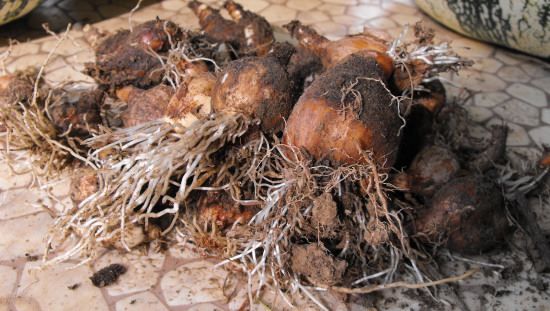
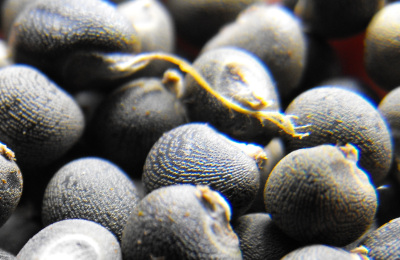 Last year's garden was a big success, but we
started running out of various frozen veggies around Christmas time,
and I vowed to do better this year. In some ways I did --- the
freezer is packed and I think we may manage to make it all the way
through until spring without buying fresh produce. But I also
made a rookie mistake, allowing the garden to expand beyond our ability
to care for it. In the process, I let some things slide, saving
seeds being foremost among the slippage.
Last year's garden was a big success, but we
started running out of various frozen veggies around Christmas time,
and I vowed to do better this year. In some ways I did --- the
freezer is packed and I think we may manage to make it all the way
through until spring without buying fresh produce. But I also
made a rookie mistake, allowing the garden to expand beyond our ability
to care for it. In the process, I let some things slide, saving
seeds being foremost among the slippage.With the frost approaching, I set out to collect some okra seeds. Of course, once I slit the drying pods open with my thumb and flipped out the textured seeds, I realized that I couldn't save okra this year after all --- I planted two varieties together and okra readily cross-pollinates. Still, I managed to gain a few intriguing pictures out of the process, so overall it was a success.
Varieties
we loved:
And were disappointed by:
|
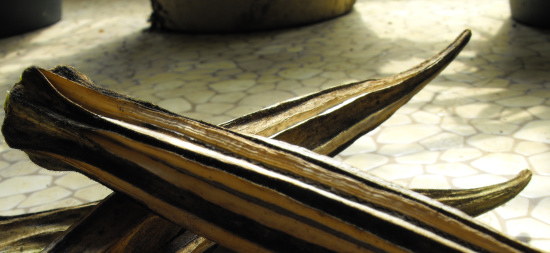
| Read other posts about saving seeds: |
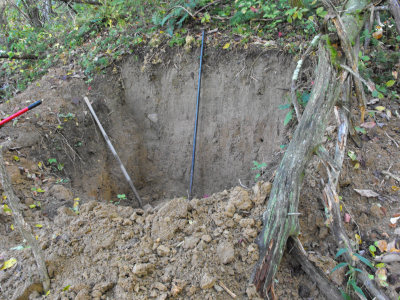 The best thing about working a part time job
from home is that when Friday rolls around, you might have only one
hour left on the clock. You can read in bed until 10 am, feed the
animals, and still be done working by noon. Oh, glorious day!
The best thing about working a part time job
from home is that when Friday rolls around, you might have only one
hour left on the clock. You can read in bed until 10 am, feed the
animals, and still be done working by noon. Oh, glorious day!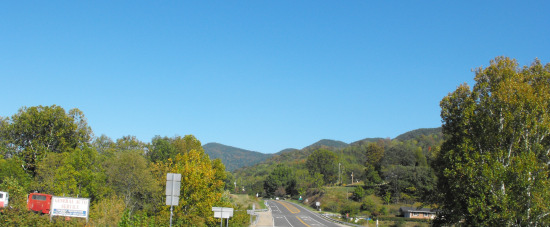
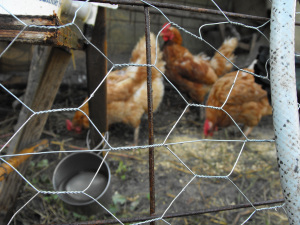
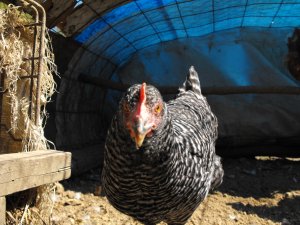

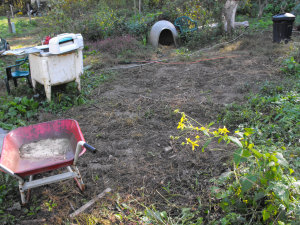
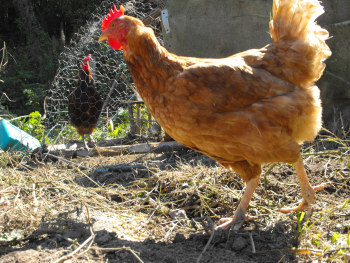
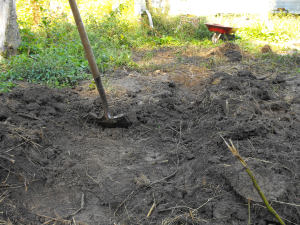
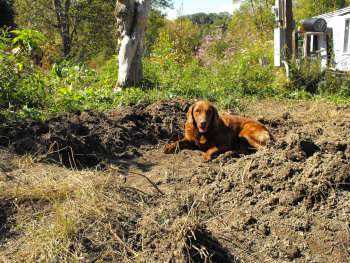 In my garden, I try to to keep beds running in perfect rows,
but this bed will be at an angle to the other beds since it would
otherwise bisect one of Lucy's paths. I've learned the hard way
that it's a lot easier to plan your beds around where the dog runs than
to try to train the dog to run somewhere else!
In my garden, I try to to keep beds running in perfect rows,
but this bed will be at an angle to the other beds since it would
otherwise bisect one of Lucy's paths. I've learned the hard way
that it's a lot easier to plan your beds around where the dog runs than
to try to train the dog to run somewhere else!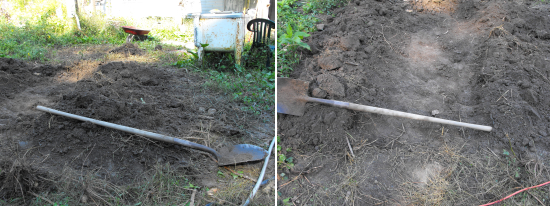
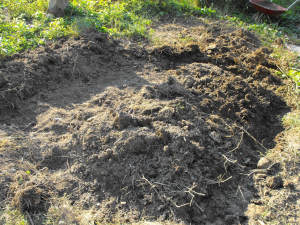

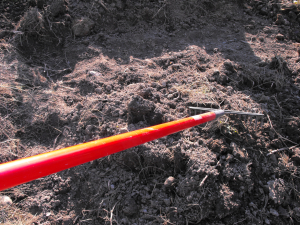
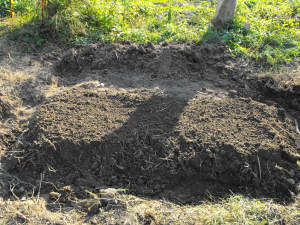
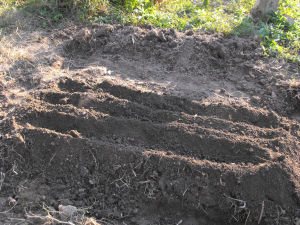
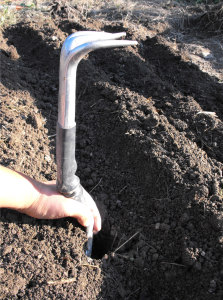
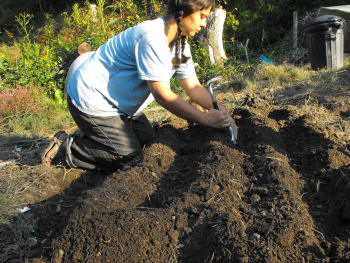
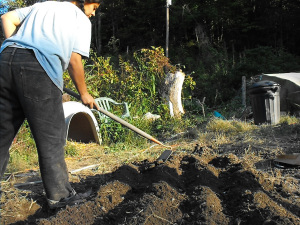
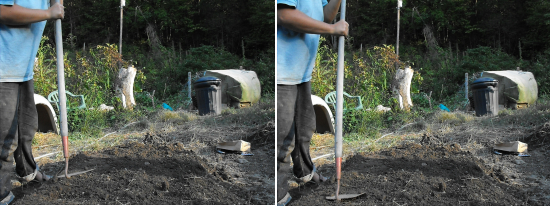
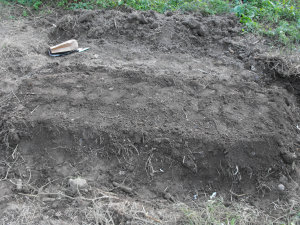
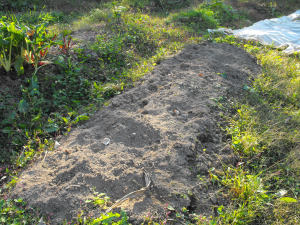

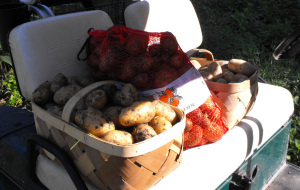
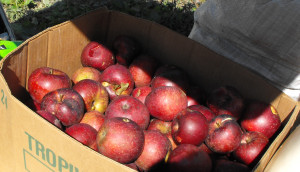 In the two years Mark and I have lived on the
farm, we've started to put down roots, to build our own
community. Yesterday, I traded my unwanted potatoes (which turned
out to be Kinnebecs --- I was confused about which variety we like and
which we dislike) to my co-worker for a mass of winesap apples.
Today, we collected some honey from the movie star in exchange for
helping with his bees a few months ago, and some Yukon Gold potatoes
(the kind we actually like) in exchange for helping with his sweet
potato harvest.
In the two years Mark and I have lived on the
farm, we've started to put down roots, to build our own
community. Yesterday, I traded my unwanted potatoes (which turned
out to be Kinnebecs --- I was confused about which variety we like and
which we dislike) to my co-worker for a mass of winesap apples.
Today, we collected some honey from the movie star in exchange for
helping with his bees a few months ago, and some Yukon Gold potatoes
(the kind we actually like) in exchange for helping with his sweet
potato harvest. 
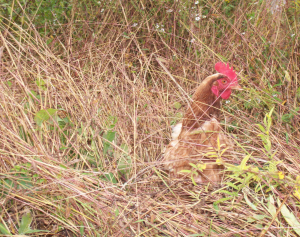 Today's experiment in simplicity was cooking
an old rooster. The neighbor of our chicken-slaughtering buddies
asked them if they'd be willing to kill and dress two of his old
roosters for him, but when the neighbor came back and saw what the
dressed chickens looked like --- all legs and no breast --- he said no
thanks and left the roosters behind. Mark and I are always up for
a challenge, so we took one home to cook.
Today's experiment in simplicity was cooking
an old rooster. The neighbor of our chicken-slaughtering buddies
asked them if they'd be willing to kill and dress two of his old
roosters for him, but when the neighbor came back and saw what the
dressed chickens looked like --- all legs and no breast --- he said no
thanks and left the roosters behind. Mark and I are always up for
a challenge, so we took one home to cook.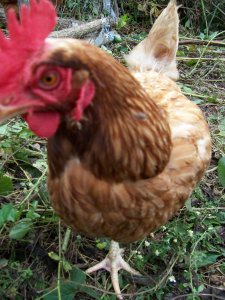 At 8:30 am, I put the whole rooster in a pot
of water with a few chopped onions and garlic and some parsley and
thyme out of the garden. (I've found that parsley can be
substitued for celery to good effect in nearly all recipes and is much
easier to grow!) Then I slowly simmered the budding stew for
about eight hours.
At 8:30 am, I put the whole rooster in a pot
of water with a few chopped onions and garlic and some parsley and
thyme out of the garden. (I've found that parsley can be
substitued for celery to good effect in nearly all recipes and is much
easier to grow!) Then I slowly simmered the budding stew for
about eight hours. 
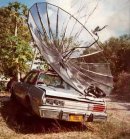
 The real hero of my low budget entertainment world is the
good people at Netflix. We spend 14 dollars and some change each month
for the 2 movies unlimited option which usually works out to about 2 or
3 films per week. What I like most about their service is the easy to
use website and impressive selection of titles. They have a new
on demand feature that lets you watch movies instantly over the
internet. It works pretty good, but it only works with Windows XP or
Vista and then you are required to use the Explorer web browser. I've
heard they are working on a Mac option, but I wouldn't hold your breath.
The real hero of my low budget entertainment world is the
good people at Netflix. We spend 14 dollars and some change each month
for the 2 movies unlimited option which usually works out to about 2 or
3 films per week. What I like most about their service is the easy to
use website and impressive selection of titles. They have a new
on demand feature that lets you watch movies instantly over the
internet. It works pretty good, but it only works with Windows XP or
Vista and then you are required to use the Explorer web browser. I've
heard they are working on a Mac option, but I wouldn't hold your breath.


 The next step up in electric mobility would be converting
a motorcycle.
The average low end cost seems to be about 1500 dollars with some
people managing a bit under that and most going several thousand over.
You can expect to get somewhere between a 10 and 50 mile range on each
charge depending on road conditions and how good your batteries are.
The next step up in electric mobility would be converting
a motorcycle.
The average low end cost seems to be about 1500 dollars with some
people managing a bit under that and most going several thousand over.
You can expect to get somewhere between a 10 and 50 mile range on each
charge depending on road conditions and how good your batteries are.
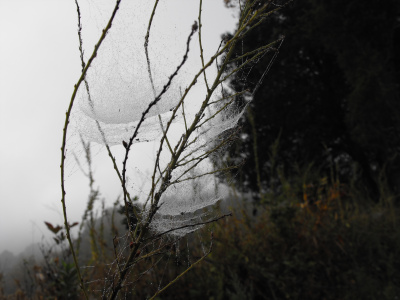
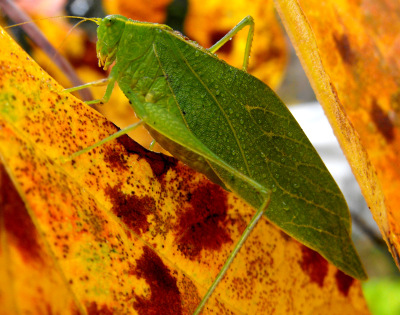


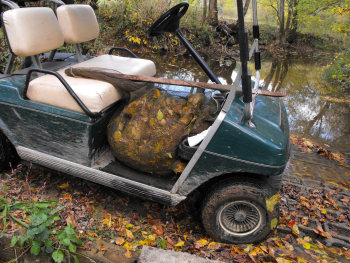

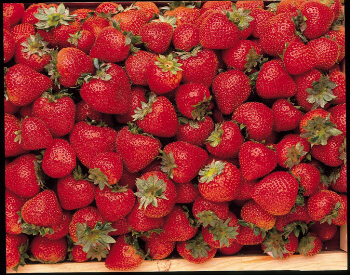 I was thrilled by the number of you who dropped your name
in the hat for last week's daffodil giveway! Mark thought I
should add a note before this week's giveaway, though --- just in case
you're worried, we don't sell your contact information, and actually
don't use it for anything except for emailing you if you're the winner.
I was thrilled by the number of you who dropped your name
in the hat for last week's daffodil giveway! Mark thought I
should add a note before this week's giveaway, though --- just in case
you're worried, we don't sell your contact information, and actually
don't use it for anything except for emailing you if you're the winner.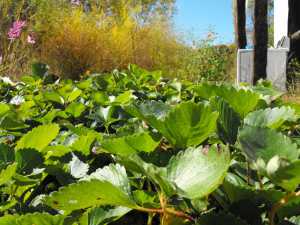 I won't know for sure the
proportions I have of each variety until I dig them, but I'll include
Honeoye Strawberries (the absolutely most delicious strawberry you'll
ever taste), Jewel Strawberries (my CSA customers told me this was the
most delicious strawberry they'd ever tasted, but that's only because I
kept the Honeoyes for myself), and a few Ozark Beauty
Strawberries. Honeoye are early June strawberries, Jewel are
later but still spring-bearing, and Ozark Beauties are
ever-bearing. The picture of the berries above is stolen off the
internet because my strawberries very seldom even made it into the
house. (Poor Mark needs to learn to wake up earlier if he wants
to get any strawberries....)
I won't know for sure the
proportions I have of each variety until I dig them, but I'll include
Honeoye Strawberries (the absolutely most delicious strawberry you'll
ever taste), Jewel Strawberries (my CSA customers told me this was the
most delicious strawberry they'd ever tasted, but that's only because I
kept the Honeoyes for myself), and a few Ozark Beauty
Strawberries. Honeoye are early June strawberries, Jewel are
later but still spring-bearing, and Ozark Beauties are
ever-bearing. The picture of the berries above is stolen off the
internet because my strawberries very seldom even made it into the
house. (Poor Mark needs to learn to wake up earlier if he wants
to get any strawberries....)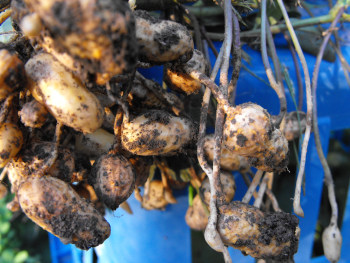
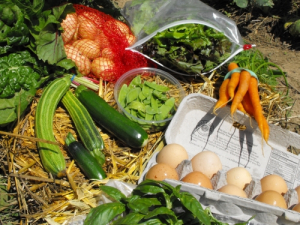
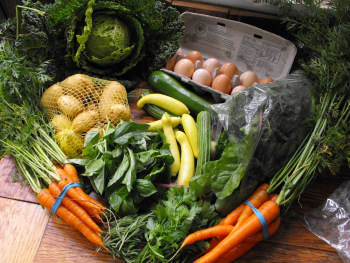
 It's almost been a year since I first discovered
Foamhenge, and I look
forward to the day when I can return. It's a good low budget day trip
if you live semi-close to Lexington, Virginia. The admission price is
zero and it's just a mile north of Natural Bridge Park with a very
pleasing view of the Blue Ridge Mountains in the back drop.
It's almost been a year since I first discovered
Foamhenge, and I look
forward to the day when I can return. It's a good low budget day trip
if you live semi-close to Lexington, Virginia. The admission price is
zero and it's just a mile north of Natural Bridge Park with a very
pleasing view of the Blue Ridge Mountains in the back drop.
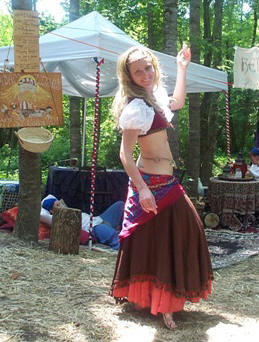 We have already decided to add next year's Renaissance
festival at Foamhenge to our social calender. It's going to be mid
September and the admission price will be 5 dollars.
We have already decided to add next year's Renaissance
festival at Foamhenge to our social calender. It's going to be mid
September and the admission price will be 5 dollars.  The stock market is making everybody nervous these days,
and what's most unsettling for me is the multi level explanations that
are being offered up on the radio and web. I wished I had paid
more attention in Mrs Lane's Economics class back in high school. I'm
sure I'm not the only one who is a bit fuzzy on all the details of last
week's stock market crash.
The stock market is making everybody nervous these days,
and what's most unsettling for me is the multi level explanations that
are being offered up on the radio and web. I wished I had paid
more attention in Mrs Lane's Economics class back in high school. I'm
sure I'm not the only one who is a bit fuzzy on all the details of last
week's stock market crash. 

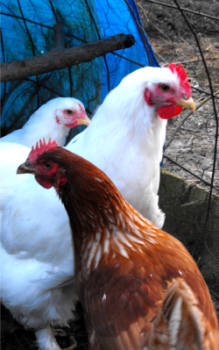 I woke at dawn yesterday to a rooster...duet?!?
I woke at dawn yesterday to a rooster...duet?!?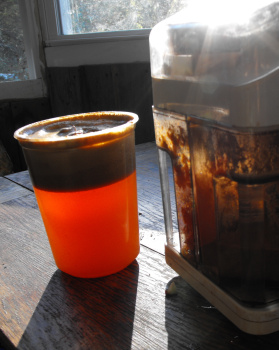 After giving away, saucing, and drying two
thirds of our traded apples, I've been pondering making cider out of
the rest. Mark suggested seeing what the juicer would do with
them, but I creased my brow and denied its utility for all I was
worth. "We'll have to cut them up and it'll take
After giving away, saucing, and drying two
thirds of our traded apples, I've been pondering making cider out of
the rest. Mark suggested seeing what the juicer would do with
them, but I creased my brow and denied its utility for all I was
worth. "We'll have to cut them up and it'll take 

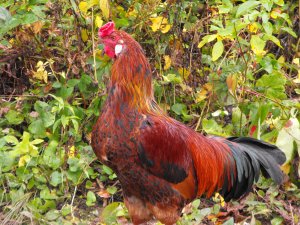 to separate her, and we nursed her back to health. She
usually gets let out during the day after she lays her egg because she
is all cooped up by herself and we figure she can use the company.
to separate her, and we nursed her back to health. She
usually gets let out during the day after she lays her egg because she
is all cooped up by herself and we figure she can use the company. 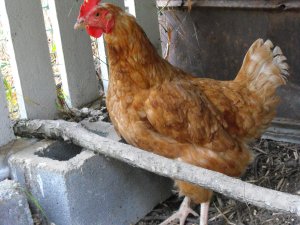 It took the rooster about 20 minutes before he decided
that our free range hen needed to be eliminated. He started chasing her
across the garden and cornered her by the collapsed old house. He then
started attacking with a vengeance. We quickly returned her to the
lone coop for an afternoon of recooperation.
It took the rooster about 20 minutes before he decided
that our free range hen needed to be eliminated. He started chasing her
across the garden and cornered her by the collapsed old house. He then
started attacking with a vengeance. We quickly returned her to the
lone coop for an afternoon of recooperation. This morning, Mark and I followed coal trucks
up the highway to go to court in Wise. We weren't in trouble, but
some friends of ours were --- young people who had chained themselves
to barrels last month to protest the construction of a coal-fired power
plant which is being built about ten miles from our farm, and about two
miles from another coal-fired power plant. (The picture to the
left is the power company's idea of what the plant will look like, with
a little smoke photoshopped in by me to make it more realistic.)
This morning, Mark and I followed coal trucks
up the highway to go to court in Wise. We weren't in trouble, but
some friends of ours were --- young people who had chained themselves
to barrels last month to protest the construction of a coal-fired power
plant which is being built about ten miles from our farm, and about two
miles from another coal-fired power plant. (The picture to the
left is the power company's idea of what the plant will look like, with
a little smoke photoshopped in by me to make it more realistic.)
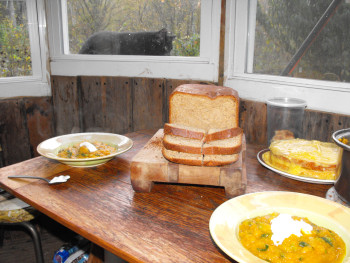 While starting on supper this evening, I
realized that I could only barely read the recipe for Butternut Squash
and Egyptian Onion Soup in my recipe book because of an oil
spill. As I pondered recopying the recipe, I realized that others
might like to try some of our favorite meals.
While starting on supper this evening, I
realized that I could only barely read the recipe for Butternut Squash
and Egyptian Onion Soup in my recipe book because of an oil
spill. As I pondered recopying the recipe, I realized that others
might like to try some of our favorite meals.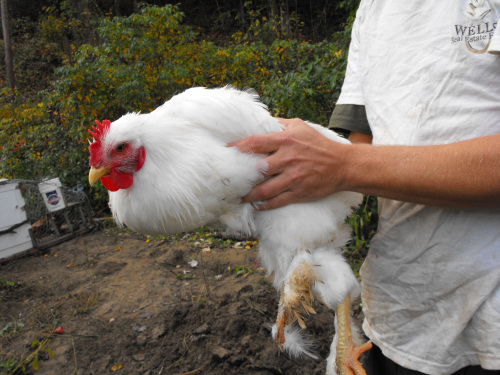
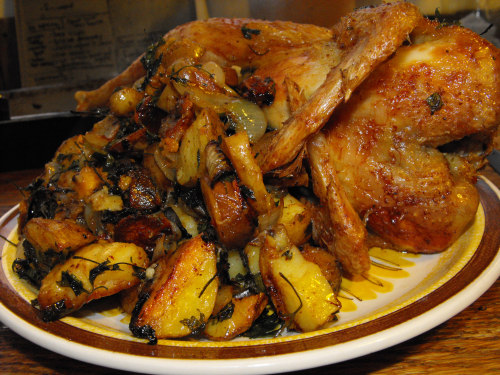

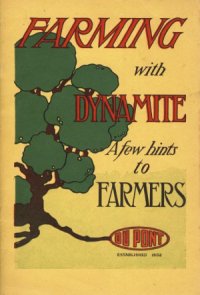
 Three weeks ago, I thought for sure the frost
was going to come early. I scurried, I picked, I covered, I
mulched. But the temperature only dropped to 33 that night, and
then warm days set in until I forgot all about the frost.
Three weeks ago, I thought for sure the frost
was going to come early. I scurried, I picked, I covered, I
mulched. But the temperature only dropped to 33 that night, and
then warm days set in until I forgot all about the frost.  One of the men mentioned that he'd lost his
second job, and was also battling cancer, and has two kids to
feed. I asked if I could send him home with some produce.
Sweet potatoes? No, his kids wouldn't eat them.
Greens? He had plenty in his own garden. Green
peppers? There I hit the jackpot, since I have dozens of green
peppers which must be eaten ASAP and don't really like them. So I
picked him a couple dozen, wishing I could do more. It seems like
he should be able to get a special hunting license which allows him to
hunt out of season due to his need and the deer overpopulation....
One of the men mentioned that he'd lost his
second job, and was also battling cancer, and has two kids to
feed. I asked if I could send him home with some produce.
Sweet potatoes? No, his kids wouldn't eat them.
Greens? He had plenty in his own garden. Green
peppers? There I hit the jackpot, since I have dozens of green
peppers which must be eaten ASAP and don't really like them. So I
picked him a couple dozen, wishing I could do more. It seems like
he should be able to get a special hunting license which allows him to
hunt out of season due to his need and the deer overpopulation.... Our property is rich in water, but none of it
is safe to drink. We have two creeks which work great for
irrigating the garden and a hand-dug well which people presumably drank
from decades ago. Unfortunately, the well tested positive for
coliform bacteria.
Our property is rich in water, but none of it
is safe to drink. We have two creeks which work great for
irrigating the garden and a hand-dug well which people presumably drank
from decades ago. Unfortunately, the well tested positive for
coliform bacteria.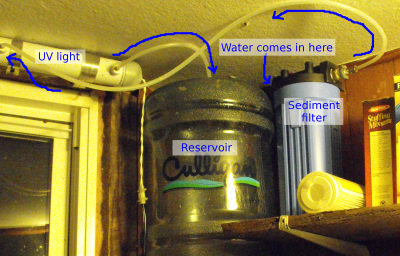 The one thing you have to be aware of when
installing a UV treatment system is that the water needs to be very
clear for the system to be effective. Any tiny grains of dirt
suspended in the water will act as a shield, protecting bacteria from
the light and making the "treated" water unsafe. The bare minimum
is to install a 5 micron sediment filter upstream of the UV light
system so that the water runs through the sediment filter and is
cleaned before running through the UV system. You can get
sediment filters just about anywhere, but we got ours from the same
place to save on shipping. In the end, our treatment system cost
under $200.
The one thing you have to be aware of when
installing a UV treatment system is that the water needs to be very
clear for the system to be effective. Any tiny grains of dirt
suspended in the water will act as a shield, protecting bacteria from
the light and making the "treated" water unsafe. The bare minimum
is to install a 5 micron sediment filter upstream of the UV light
system so that the water runs through the sediment filter and is
cleaned before running through the UV system. You can get
sediment filters just about anywhere, but we got ours from the same
place to save on shipping. In the end, our treatment system cost
under $200.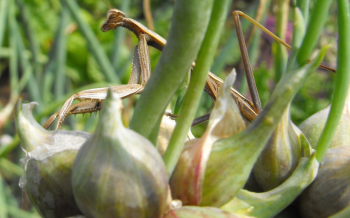 I know I promised you all flowers for the next
giveaway. But...I lied.
I know I promised you all flowers for the next
giveaway. But...I lied.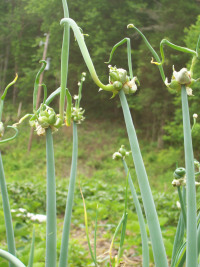 Egyptian onions are the base of one of our
favorite recipes ---
Egyptian onions are the base of one of our
favorite recipes --- 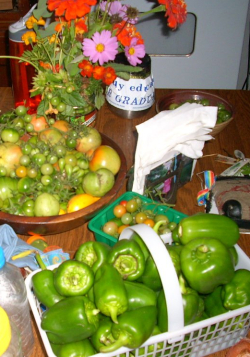 My mother and sister live in town, but manage
to grow quite a bit of food in their backyard. Maggie (my sister)
sent me this photo today showing some of the peppers and tomatoes they
harvested just before their first frost.
My mother and sister live in town, but manage
to grow quite a bit of food in their backyard. Maggie (my sister)
sent me this photo today showing some of the peppers and tomatoes they
harvested just before their first frost.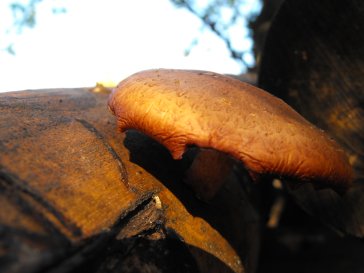

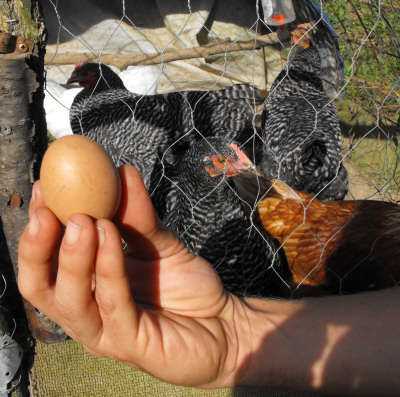
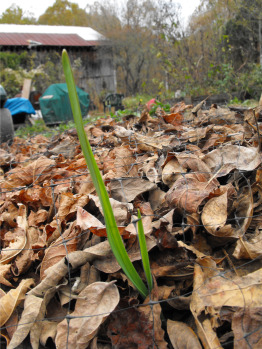 The first garlic shoots have slipped up
through the leaves 19 days after going into the ground. Already I
can see a difference between the chunky shoots on this year's garlic
and the spindly leaves which came up from the grocery store garlic I
planted last year.
The first garlic shoots have slipped up
through the leaves 19 days after going into the ground. Already I
can see a difference between the chunky shoots on this year's garlic
and the spindly leaves which came up from the grocery store garlic I
planted last year.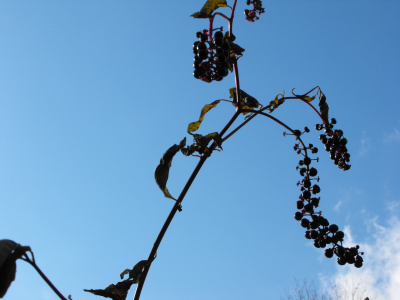 You know you're living in paradise when you go
on vacation but leave early to go straight home....
You know you're living in paradise when you go
on vacation but leave early to go straight home.... 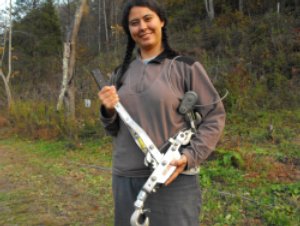 each end, and a good old fashioned chain. These items are
needed to attach your winch to a tree, heavy duty vehicle, boulder,
etc. Extreme care should be taken when operating any type of winch
where several hundred or thousand pounds are being held. The cable can
end up holding a tremendous amount of potential energy, and if there is
a
break or slip then that energy needs to go somewhere, and if you're in
its way it might be the last mistake you make. I try to imagine the
path the cable might take if it did break, and stay clear and make sure
any bystanders are plenty out of the way.
each end, and a good old fashioned chain. These items are
needed to attach your winch to a tree, heavy duty vehicle, boulder,
etc. Extreme care should be taken when operating any type of winch
where several hundred or thousand pounds are being held. The cable can
end up holding a tremendous amount of potential energy, and if there is
a
break or slip then that energy needs to go somewhere, and if you're in
its way it might be the last mistake you make. I try to imagine the
path the cable might take if it did break, and stay clear and make sure
any bystanders are plenty out of the way. 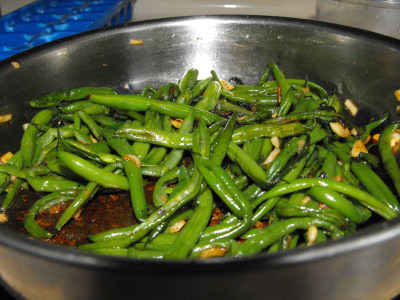 A week of heavy frosts later, our garden is
pretty much barren. We've got plenty of greens and lettuce, a few
carrots, and not much else.
A week of heavy frosts later, our garden is
pretty much barren. We've got plenty of greens and lettuce, a few
carrots, and not much else.
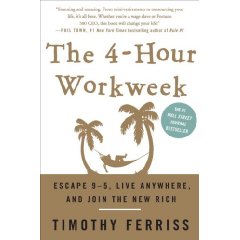
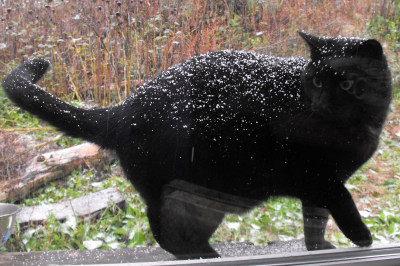






 If late summer got away from you and you never
managed to plant a fall garden --- join the club. Luckily, you've
got one more chance at planting something easy and delicious that will
feed you well into December.
If late summer got away from you and you never
managed to plant a fall garden --- join the club. Luckily, you've
got one more chance at planting something easy and delicious that will
feed you well into December. 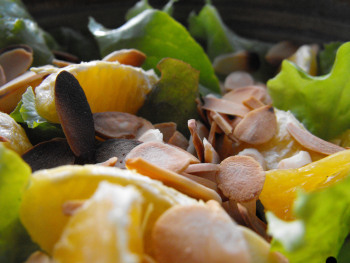 Check out my
Check out my 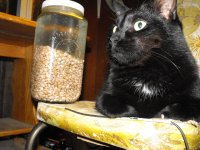
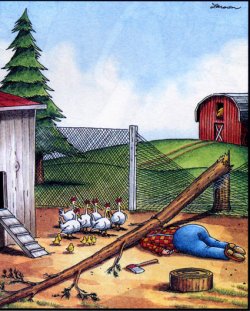
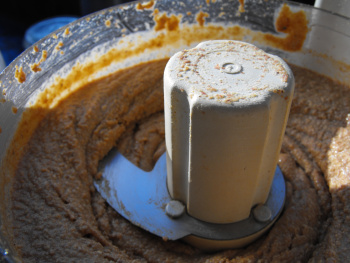 Unlike most of you, I wasn't raised on peanut
butter. I can remember when I first tasted peanut butter as a
child --- freshly ground in the machines at the GNC in the mall.
The gunky paste quickly became one of my favorite foods and I was
thrilled to eat peanut butter sandwiches in my lunch box for years.
Unlike most of you, I wasn't raised on peanut
butter. I can remember when I first tasted peanut butter as a
child --- freshly ground in the machines at the GNC in the mall.
The gunky paste quickly became one of my favorite foods and I was
thrilled to eat peanut butter sandwiches in my lunch box for years.